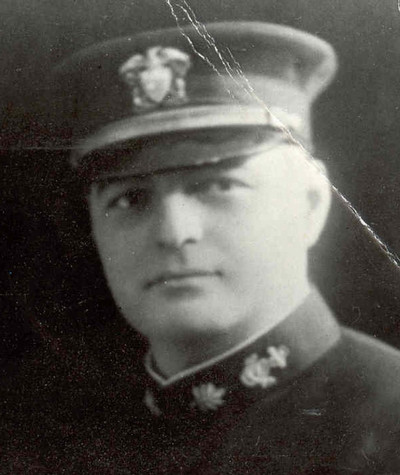Great Clemson Graduates

Ensign Daniel Sullivan (1884-1941)
Daniel A. J. Sullivan was born on July 31, 1884, in Charleston, South Carolina. He attended Clemson Agricultural College and was a private in Company A of the Cadet Corps. In June 1902, Sullivan graduated from Clemson with a Mechanical Engineering degree. An Ensign in the U. S. Naval Reserve Force in World War I, he was given the Medal of Honor for extraordinary heroism as an officer of the U.S.S. Christabel [Destroyer] on May 21, 1918. This award was given on Nov. 11, 1920. He died in New York on Jan. 29, 1941, and is buried in Arlington National Cemetery.

Lt. Col. Aquilla James Dyess (1909-1944)
Lt. Col. Dyess was born on Jan. 11, 1909, in Andersonville, Georgia. As a young man, he achieved the rank of Eagle Scout in the Boy Scouts. Later in his life, in 1928, he demonstrated his courage by rescuing two swimmers from drowning off the coast of Charleston, South Carolina. The following year, he was awarded the Carnegie Medal, the highest civilian medal for heroism, for his life-saving act. From 1928 to 1932, he attended Clemson College, which was the name of the University at the time. He was commissioned into the U.S. Army Reserve in 1931 before graduating in 1932, and in November 1936, he transferred over to the U.S. Marine Corps Reserve as a 1st Lieutenant. During the following years leading up to the United States' entry into World War II, he was a part of the Marine Corps Rifle Team, where he received numerous medals for his excellent marksmanship. After the bombing of Pearl Harbor, he was placed as a Lieutenant Colonel in command of the First Battalion, Twenty-Fourth Marines, Fourth Marine Division. On Feb. 2, 1944, in the battle for the Marshall Islands, Lt. Col. Dyess was on the Japanese-held Namur Island. While attacking the final Japanese position on the northern part of the island, Dyess valiantly led his men from an exposed position between the two opposing lines of force. On that day, whenever the enemy gunfire worsened and slowed the advance of the marines, Dyess would quickly appear and place himself at the head of his men, inspiring them to continue on. While he was directing a group of infantry in a flanking attack, he was killed by a burst of enemy gunfire. He was posthumously awarded the Medal of Honor for his "conspicuous gallantry and intrepidity" on that day. He is the only American to receive both the Medal of Honor and the Carnegie Medal.

Sgt. Evans Foster (1894-1951)
Sgt. Foster was born on Nov. 6, 1894, in Spartanburg, South Carolina. During his childhood, he was raised in South Carolina, and he volunteered for the U.S. Army when the United States entered World War I. He fought in the battle for France throughout the year 1918. On Oct. 8, 1918, near the town of Montbrehain, he fought with such valor in the face of the enemy barrage that he was later awarded the Medal of Honor. The citation reads as follows: "When his company was held up by violent machine-gun fire from a sunken road, Sgt. Foster, with an officer, went forward to attack the hostile machine-gun nests. The officer was wounded, but Sgt. Foster continued on alone in the face of the heavy fire, and by effective use of hand grenades and his pistol, killed several of the enemies and captured 18." Sgt. Foster attended Clemson College after returning home from the war.

Major Rudolf Anderson Jr. (1927-1962)
Major Anderson was born in Greenville, South Carolina, on Sept. 15, 1927. In his youth, he achieved the Eagle Scout rank for Boy Scout Troop 19. He attended Clemson College in the mid-1940s, graduating in 1948 and earning a commission in the newly created Air Force. After the breakout of the Korean War, he was sent to fly the F-86 Sabre over the skies of North Korea. He logged more than 2,000 flying hours in the Sabre. For his actions during the war, he was awarded the Distinguished Flying Cross with two clusters. He stayed in the Air Force for the next ten years and had three children with his loving wife, Frances Corbett. In October 1962, the Cuban Missile Crisis engulfed the country and most of the world. Major Anderson was flying the U-2 reconnaissance spy plane, which operates at 70,000 ft. On Oct. 27, while on a mission over Cuba, his plane was shot down by a Soviet surface-to-air missile. He was posthumously awarded both the Distinguished Service Medal and the Air Force Cross. The following is an excerpt from the citation given for the Air Force Cross: "During this period of great national crisis, Major Anderson, flying an unescorted, unarmed aircraft, lost his life while participating in one of several aerial reconnaissance missions over Cuba. While executing these aerial missions, Major Anderson made photographs that provided the United States government with conclusive evidence of the introduction of long-range offensive missiles into Cuba and which materially assisted our leaders in charting the nation's military and diplomatic course. Through his extraordinary heroism, superb airmanship, and aggressiveness in the face of the enemy, Major Anderson reflected the highest credit upon himself and the United States."

